Believe it or not, studying a degree in graphic design won’t limit your career path to pure graphic design, but rather open up a variety of paths for you to explore.
If you’re wondering how a graphic design degree can help you achieve professional success in an area you enjoy, read on to find out more about the careers and further education you could pursue.
Career paths to consider
Graphic designer
The most obvious path, though not the one everyone will choose. A graphic designer may work as an employee for a company or as a freelancer. What a graphic designer works on can vary from job to job, but will likely cover at least one of the following: websites, signage, magazines, posters, product packaging, computer games and marketing materials. A graphic designer will work to deliver any project they are assigned to the designated deadline, and although most use CAD packages, others may work by hand. Creative flair is essential for this role, as is the ability to manage your own time and juggle several projects at once. The starting salary for a graphic designer usually lies in the region of £17,000.
Illustrator
An illustrator, more often than not, works as a freelancer and uses their artistic talent to create illustrations for a number of purposes. These include but are not limited to advertising, multimedia, publishing, fashion and merchandising. Similarly to a graphic designer, an illustrator must work to a specific brief to ensure that they meet their clients’ needs. Although closely associated with hand-drawn images, an illustrator may also use photography or digital illustration, depending on their brief. As well as generic illustrators, there are also those with specialisms; these include scientific and medical illustrators. Typically, the starting salary for an illustrator would sit somewhere between £15,000 and £20,000.
Animator
An animator uses a variety of methods – including models, digital images and hand-drawn images – to produce sequences that appear as though they are moving. The work of an animator will typically fit into one of four categories: 2D, 3D, stop frame or computer-generated. Animators are usually expected to liaise with clients before beginning work on storyboarding and, subsequently, designing models, backgrounds, sets, characters and objects. Animators use software packages such as Flash, 3ds Max and LightWave, to aid them in completing projects. On average, the majority of entry level animator positions pay £12,000 to £15,000, although games design may offer salaries around the £18,000 mark.
Production designer
A production designer is essentially the person in charge of creating the visual concept for a film, television programme or theatre production. They must consider a wide scope of factors that contribute to the production’s overall feel, including locations, sets, props, lighting and costumes. Rather than making decisions alone, a production designer must work closely with directors and producers to find outcomes that everyone can agree on. Although many specialise in either film, TV or theatre, others try their hand at each. It is practically unheard of to secure a role as a production designer without some years of industry experience, so although a graphic design degree may help you along the way, you’d likely have to work your way up from the bottom in one of the three areas.
Continuing your education
If you’re hoping to specialise in a certain area of graphic design, enrolling onto a master’s degree programme is certainly a great way of doing this. Not only will you develop the artistic skills needed to stay one step ahead of the rest, but you may also benefit from the opportunity of networking with those who you can creatively collaborate with, including other students studying subjects relevant to the field you wish to enter.
If you find yourself wanting to learn more, but unable to commit to a full-time master’s programme, you could consider taking short courses covering artistic areas that you wish to explore.
At LCCA, we offer several graphic design courses, including BA Graphic Design and Visual Communication and a Digital Graphic Design Fundamentals short course. For more information, please visit our course pages.
